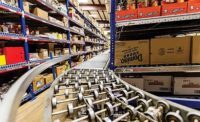When it comes to getting their products to consumers, bakers and snack producers have some major hurdles to overcome. They must navigate a complex supply chain and distribution system while dealing with fluctuating ingredient availability and costs, complex batch codes and often short expiration dates.
Like other food manufacturers, bakers and snack producers also must meet government regulations regarding food safety. These regulations require companies to track and trace food products throughout the supply chain, from raw materials through delivery.
Many baked goods and snacks must reach supermarket shelves in a timely fashion. Therefore, delivery route plans must be logical, realistic and achievable. Manufacturers know that consumers will often opt for competing brands if theirs aren’t available, so keeping retail customers stocked is crucial.
Recent developments
The latest trend in logistics software is two-fold, according to David F. Giannetto, senior vice president of performance management, Salient Management Co., Horseheads, NY. “First is functionality that helps food processors spot anomalies and trends that they can act upon—anything from vendor performance to suspect ingredients,” he explains. “Second is the inclusion of big data within enterprise data sets to show how these larger, often consumer-oriented trends are influencing an organization.”
Derek Curtis, vice president of sales, HighJump Software, Minneapolis, says predictive ordering is a growing trend in logistics. “The analysis of trends, seasonal factors or single-store sales history to calculate suggested order quantities is a powerful tool to ensure the product is on the shelf and ready for sale, while minimizing waste,” he notes.
The concept of warehouse execution systems (WES) in logistics is also gaining popularity among manufacturers, according to Dave Williams, director of software development, Westfalia Technologies Inc., York, PA. “Instead of requiring a separate warehouse management and control system, a WES can help bakeries and snack food plants move product more efficiently because it simplifies all warehouse communication and controls, and reduces the need for complex ‘function-specific’ applications. As a result, producers have greater traceability of product throughout their operations.”
Fleet integration and links with vehicle tracking can deliver big benefits, says William Salter, president and CEO, Paragon Software Systems Inc., Frisco, TX. The company’s Paragon Integrated Fleets module enables users to manage their entire truck fleet as one integrated resource, regardless of location. This ensures that transportation teams are moving ingredients and finished products through their supply chains as efficiently as possible.
“The introduction of vehicle tracking takes benefits to the next level,” Salter explains. “If you use Paragon to create your route plan, but then take the tracking feed from your in-cab tracking provider, you can look at planned versus actual vehicle performance both in real time and at the end of each day. By taking this real-life, ‘out-on-the-road’ information, you can easily address reoccurring issues and refine your route plans using real-world information.”
Going mobile
Cloud-based computing technology and related mobility solutions are impacting logistics, as well. “Cloud and multitenant deployment models are transforming the supply chain execution software market,” says Kevin Hume, partner, Tompkins International, Raleigh, NC. “The need for improved accuracy in retail stores is driving wider adoption of Cloud-SaaS models, offering faster deployment times and lower operating costs.” As a result, Android- and iOS-based devices are gaining wider adoption with simpler user interfaces and wider scale-of-deployment increases.
Mobility solutions are no longer limited to handheld devices and barcode scanners, according to Williams. “There is greater emphasis on executive reporting solutions, which are becoming more widely available on tablets, smartphones and other mobile device,” he says. “This gives the end user more freedom and makes it easier to obtain the information needed to maintain and operate warehouse systems.”
In 2014, the majority of software applications were accessed via non-desktop devices. This trend is expected to continue as more individuals access information via their smartphones and tablets. “It is more efficient to use cloud-based solutions from mobile devices,” says Jim Taylor, vice president of information technology, Transportation Insight, Hickory, NC. “Someone at a retail establishment can access the information they need in real time. The use of cloud and mobile technologies will continue to grow as it provides convenience and efficiency improvements.”
Logistics software is becoming more flexible and scalable, thereby providing benefits to a larger business segment. “The small-to-medium business sector has been able to take advantage of this scalability and realize benefits,” says Bruce Stubbs, director of industry marketing, Honeywell Scanning & Mobility, Fort Mill, SC. “Rather than being customizable, though, the software is becoming configurable.” He noted that this allows users to adjust settings and results based on changes in business operations and realize a greater return on investment.
To measure the flexibility of logistics software, bakery and snack food producers must make sure that potential vendors offer device-agnostic hardware that includes rugged and consumer-grade/PDA options; integrates with enterprise resource planning (ERP) systems; has a customizable and configurable workflow; and provides access to real-time business information, according to Curtis.
Predictive analysis has been touted as a key trend in logistics software development, but some vendors disagree. “Using data mined from logistics systems can be helpful in making better decisions with respect to production and distribution, but data is most useful when it is presented in an actionable format in real time,” says Stubbs. “Then, it truly becomes a ‘currency’ for the organization.” Using automated data-capture equipment to access and present real-time data from logistics systems is the best way to realize the benefits of data.
“Predictive analytics is a buzz phrase that won’t go away,” says Giannetto. “Every key software group is trying to make their software more predictive—everything from predicting freight costs, to factoring in weather delays on production and delivery, to identifying likely areas of failure in manufacturing and delivery processes.”
Yet, using predictive analytics is still beyond most organizations’ reach. Most would benefit from better core information that clearly shows where and how they can improve their bottom line through productivity, process and technology changes, he adds.
On the horizon
While many logistics software tools already are available to help manufacturers run their operations more efficiently, many more solutions are on the way, such as imaging, data visualization and voice-based logistics.
The ability to collect field data has been enhanced by the ability to capture images on mobile devices. These same enhancements are happening now with the collection of field documents, such as checks or store stamps, via optical character recognition.
Voice-based picking tools have been available for some time, according to Curtis. “They can be a key component for increasing efficiency in the warehouse and the retail outlet, ensuring better accuracy,” he explains. “In a freezer or refrigerated setting, voice-directed picking is safer for workers, who are exposed to the cold. It’s also an advantage in situations where gloved hands or screens can fog up or hamper other data-collection methods.”
Ralf Ulmer, president, ToolBox Software North America Inc., Scottsdale, AZ, does not consider voice picking to be suitable for all bakery and snack food operations, although bakeries that produce long-shelf-life products may benefit from voice systems. “Fresh bakery operations can operate more quickly with pick-by-light solutions,” he says. These days, pick-by-light solutions have grown into full warehouse management systems that include production recording, loading control, track-and-trace, and material-handling equipment management, he notes. “Pick-by-vision via data glasses is a future option.”
Pathway mapping is another logistics trend worth following, according to Giannetto. Traditionally used to visualize big data, pathway mapping is well-suited to show the movement of goods through a complex manufacturing process or supply chain, revealing key trends, opportunities and areas where a company can make the most improvement in the least amount of time.
Logistics software has come a long way and will continue to evolve to meet bakers’ and snack manufacturers’ unique needs. Being able to more efficiently and cost-effectively manage everything from product to delivery will enable these producers to better serve consumers and flourish.
Online exclusive: Review the free on-demand webinar, “How a DSD solution with sales forecasting can reduce your stale percentages up to 50%” at www.snackandbakery.com/webinars.









